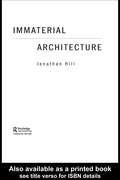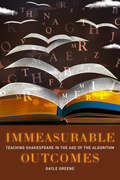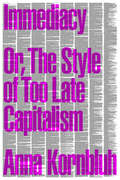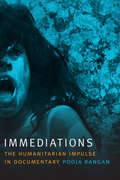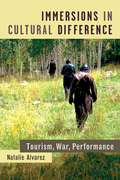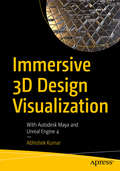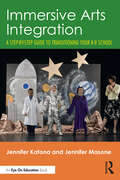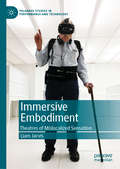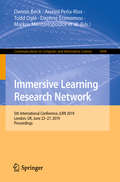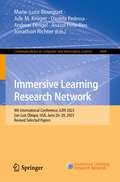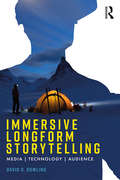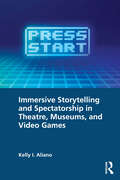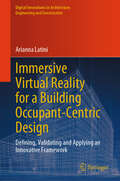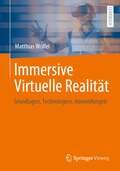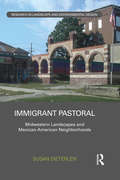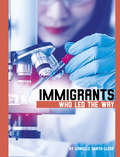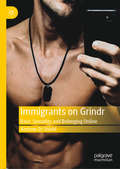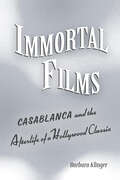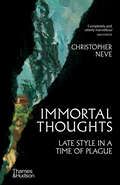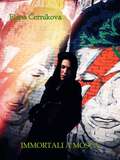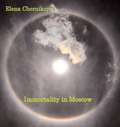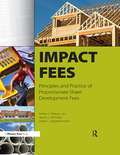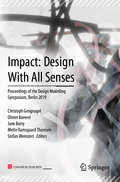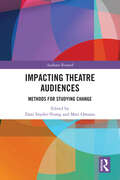- Table View
- List View
Immaterial Architecture
by Jonathan HillThis fascinating argument from Jonathan Hill presents the case for the significance and importance of the immaterial in architecture. Architecture is generally perceived as the solid, physical matter that it unarguably creates, but what of the spaces it creates? This issue drives Hill's explorative look at the immaterial aspects of architecture. The book discusses the pressures on architecture and the architectural profession to be respectively solid matter and solid practice and considers concepts that align architecture with the immaterial, such as the superiority of ideas over matter, command of drawing and design of spaces and surfaces. Focusing on immaterial architecture as the perceived absence of matter, Hill devises new means to explore the creativity of both the user and the architect, advocating an architecture that fuses the immaterial and the material and considers its consequences, challenging preconceptions about architecture, its practice, purpose, matter and use. This is a useful and innovative read that encourages architects and students to think beyond established theory and practice.
Immeasurable Outcomes: Teaching Shakespeare in the Age of the Algorithm
by Gayle GreeneWhat is the purpose of education? The answer might be found in a Shakespeare class at a small liberal arts college.In this engaging account of teaching a Shakespeare class at a small liberal arts college, Gayle Greene illustrates what is so vital and urgent about the humanities. Follow along with Greene as she introduces us to her students and showcases their strengths, needs, and vulnerabilities, so we can experience the magic of her classroom. In Immeasurable Outcomes, Greene's class builds a complex human ecosystem that pushes students to think more deeply and discover their own interests and potential, all while recognizing the inherent dignity in other people's views and values. Grounding her analyses in half a century of teaching, Greene pushes back against the demand for measurable student learning outcomes and the standardization imposed on K-12 schools in the name of reform. Instead, she draws her conclusions about education directly from the students themselves. Alumni testimonials describe the transformative power of a liberal arts education, recounting how their experience of community and engagement has provided them the tools to navigate the uncertainties of a rapidly changing world while also inspiring the social awareness our democracy depends on. Immeasurable Outcomes rejects claims that the liberal arts are impractical, exposing the political agendas of technocrats and ideologues who would transform higher education into vocational training and programs focused only on profitability. Greene reminds us that the liberal arts have been the basis for the most successful educational system in the world and provides a powerful demonstration that education at a human scale that is relationship-rich and humanities-based should be the model for education in the future.
Immediacy: Or, The Style of Too Late Capitalism
by Anna KornbluhWhy speed, flow, and direct expression now dominate cultural styleContemporary cultural style boosts transparency and instantaneity. These are values absorbed from our current economic conditions of "disintermediation": cutting out the middleman. Like Uber, but for art. Immediacy names this style to make sense of what we lose when the contradictions of twenty-first-century capitalism demand that aesthetics negate mediation. Surging realness as an aesthetic program synchs with the economic imperative to intensify circulation when production stagnates. "Flow" is the ultimate twenty-first-century buzzword, but speedy circulation grinds art down to the nub. And the bad news is that political turmoil and social challenges require more mediation. Collective will, inspiring ideas, and deliberate construction are the only way out, but our dominant style forgoes them. Considering original streaming TV, popular literature, artworld trends, and academic theories, Immediacy explains the recent obsession with immersion and today&’s intolerance of representation, and points to alternative forms in photography, TV, novels, and constructive theory that prioritize distance, impersonality, and big ideas instead.
Immediations: The Humanitarian Impulse in Documentary
by Pooja RanganEndangered life is often used to justify humanitarian media intervention, but what if suffering humanity is both the fuel and outcome of such media representations? Pooja Rangan argues that this vicious circle is the result of immediation, a prevailing documentary ethos that seeks to render human suffering urgent and immediate at all costs. Rangan interrogates this ethos in films seeking to “give a voice to the voiceless,” an established method of validating the humanity of marginalized subjects, including children, refugees, autistics, and animals. She focuses on multiple examples of documentary subjects being invited to demonstrate their humanity: photography workshops for the children of sex workers in Calcutta; live eyewitness reporting by Hurricane Katrina survivors; attempts to facilitate speech in nonverbal autistics; and painting lessons for elephants. These subjects are obliged to represent themselves using immediations—tropes that reinforce their status as the “other” and reproduce definitions of the human that exclude non-normative modes of thinking, being, and doing. To counter these effects, Rangan calls for an approach to media that aims not to humanize but to realize the full, radical potential of giving the camera to the other.
Immersions in Cultural Difference: Tourism, War, Performance
by Natalie AlvarezIn a time of intensifying xenophobia and anti-immigration measures, this book examines the impulse to acquire a deeper understanding of cultural others. Immersions in Cultural Difference takes readers into the heart of immersive simulations, including a simulated terrorist training camp in Utah; mock Afghan villages at military bases in Canada and the UK; a fictional Mexico-US border run in Hidalgo, Mexico; and an immersive tour for settlers at a First Nations reserve in Manitoba, Canada. Natalie Alvarez positions the phenomenon of immersive simulations within intersecting cultural formations: a neoliberal capitalist interest in the so-called “experience economy” that operates alongside histories of colonization and a heightened state of xenophobia produced by War on Terror discourse. The author queries the ethical stakes of these encounters, including her own in relation to the field research she undertakes. As the book moves from site to site, the reader discovers how these immersions function as intercultural rehearsal theaters that serve a diverse set of strategies and pedagogical purposes: they become a “force multiplier” within military strategy, a transgressive form of dark tourism, an activist strategy, and a global, profit-generating practice for a neoliberal capitalist marketplace.
Immersive 3D Design Visualization: With Autodesk Maya and Unreal Engine 4
by Abhishek KumarDiscover the methods and techniques required for creating immersive design visualization for industry. This book proposes ways for industry-oriented design visualization from scratch. This includes fundamentals of creative and immersive technology; tools and techniques for architectural visualization; design visualization with Autodesk Maya; PBR integration; and texturing, material design, and integration into UE4 for immersive design visualization. You’ll to dive into design and visualization, from planning to execution. You will start with the basics, such as an introduction to design visualization as well as to the software you will be using. You will next learn to create assets such as virtual worlds and texturing, and integrate them with Unreal Engine 4. Finally, there is a capstone project for you to make your own immersive visualization scene. By the end of the book you’ll be able to create assets for use in industries such as game development, entertainment, architecture, design engineering, and digital education. What You Will Learn Gain the fundamentals of immersive design visualization Master design visualization with Autodesk Maya Study interactive visualization with UE4 Create your immersive design portfolio Who This Book Is For Beginning-intermediate learners from the fields of animation, visual art, and computer graphics as well as design visualization, game technology, and virtual reality integration.
Immersive Arts Integration: A Step-by-Step Guide to Transitioning Your K-8 School
by Jennifer Katona Jennifer MasoneThis step-by-step guide takes you through the process of transitioning your K-8 school to the Immersive Arts Integration model. The model develops deeper connections with content, stronger relationships, and a positive school climate. Co-authors Dr. Jennifer Katona and Dr. Jennifer Masone combine decades of educational and artistic expertise to share a four-year roadmap to a sustainable immersive arts approach to teaching and learning. The Immersive Arts Integration model is based on five key tenets: Building Ensemble; Arts Integration into Core Content Instruction; Creating Integrated Units of Study; Elevating the Role of the Arts Specialist; and Spaces and Places. The authors explore each concept and its implementation, as well as measurable outcomes pertaining to pedagogy, academic achievement, social emotional learning, equity, multilingual learning, facilities usage, and school climate. They include resources for stakeholders across the educational spectrum to utilize and provide considerations for different staffing and fiscal models. Articulated schedules of professional development, lesson plan templates, sample lessons, and sample unit plans are also included for immediate use. Whether you are a district or school administrator or working in the classroom, you can have a hand in gaining buy-in and implementing an educational model that both infuses the arts into daily instruction and creates lasting improvement within your institution.
Immersive Embodiment: Theatres of Mislocalized Sensation (Palgrave Studies in Performance and Technology)
by Liam JarvisThis book offers a wide-ranging examination of acts of ‘virtual embodiment’ in performance/gaming/applied contexts that abstract an immersant’s sense of physical selfhood by instating a virtual body, body-part or computer-generated avatar. Emergent ‘immersive’ practices in an increasingly expanding and cross-disciplinary field are coinciding with a wealth of new scientific knowledge in body-ownership and self-attribution. A growing understanding of the way a body constructs its sense of selfhood is intersecting with the historically persistent desire to make an onto-relational link between the body that ‘knows’ an experience and bodies that cannot know without occupying their unique point of view. The author argues that the desire to empathize with another’s ineffable bodily experiences is finding new expression in contexts of particular urgency. For example, patients wishing to communicate their complex physical experiences to their extended networks of support in healthcare, or communities placing policymakers ‘inside’ vulnerable, marginalized or disenfranchised virtual bodies in an attempt to prompt personal change. This book is intended for students, academics and practitioner-researchers studying or working in the related fields of immersive theatre/art-making, arts-science and VR in applied performance practices.
Immersive Learning Research Network: 5th International Conference, iLRN 2019, London, UK, June 23–27, 2019, Proceedings (Communications in Computer and Information Science #1044)
by Leonel Morgado Johanna Pirker Dennis Beck Jonathon Richter Christian Gütl Anasol Peña-Rios Todd Ogle Daphne Economou Markos Mentzelopoulos Christian Eckhardt Roxane Koitz-Hristov Michael GardnerThis volume constitutes the refereed proceedings of the 5th International Conference of the Immersive Learning Network, iLRN 2019, held in London, UK, in June 2019.The 18 revised full papers and presented in this volume were carefully reviewed and selected from 60 submissions. The papers are organized in topical sections on science, technology, engineering, and mathematics (STEM); disciplinary applications: special education; disciplinary applications: history; pedagogical strategies; immersion and presence.
Immersive Learning Research Network: 9th International Conference, iLRN 2023, San Luis Obispo, USA, June 26–29, 2023, Revised Selected Papers (Communications in Computer and Information Science #1904)
by Jonathon Richter Anasol Peña-Rios Andreas Dengel Marie-Luce Bourguet Jule M. Krüger Daniela PedrosaThis volume constitutes the refereed proceedings of the 9th International Conference of the Immersive Learning Network, iLRN 2023, held in San Luis Obispo, USA, in June 2023 as a hybrid event.The 26 revised full papers and 13 shprt papers presented in this volume were carefully reviewed and selected from 110 submissions. The papers are organized in topical sections on foundations in immersive learning research and theory; assessment and evaluation; galleries, libraries, archives and museums; inclusion, diversity, equity, access, and social justice; STEM education; language, culture and heritage; nature & environmental sciences; workforce development & industry training; self and co-regulated learning with immersive learning environments; special track: immersive learning across Latin America: state of research, use cases and projects.
Immersive Longform Storytelling: Media, Technology, Audience
by David DowlingA deep dive into the world of online and multimedia longform storytelling, this book charts the renaissance in deep reading, viewing and listening associated with the literary mind, and the resulting implications of its rise in popularity. David O. Dowling argues that although developments in media technology have enabled the ascendance of nonfictional storytelling to new heights through new forms, it has done so at the peril of these intensely persuasive designs becoming deployed for commercial and political purposes. He shows how traditional boundaries separating genres and dividing editorial from advertising content have fallen with the rise of media hybridity, drawing attention to how the principle of an independent press can be reformulated for the digital ecosystem. Immersive Longform Storytelling is a compelling examination of storytelling, covering multimedia features, on-demand documentary television, branded digital documentaries, interactive online documentaries, and podcasting. This book’s focus on both form and effect makes it a fascinating read for scholars and academics interested in storytelling and the rise of new media.
Immersive Storytelling and Spectatorship in Theatre, Museums, and Video Games
by Kelly I. AlianoImmersive Storytelling and Spectatorship in Theatre, Museums, and Video Games is the first volume to explore immersion as it is experienced in all three of these storytelling forms: the theatre, museums and historic sites, and video games. It theorizes what it means for a work to be called immersive and how immersion impacts audience experience in each of these modes.The presentation of story is deepened when it involves the spectator in an immersive way. Author Kelly I. Aliano concentrates on the central idea that the use of immersion in each medium allows the story being told to feel present for the spectator. It puts them at the center of the experience, making its events for and about them. Throughout, the book discusses how immersion is employed to make narrative feel more resonant and relevant for the audience. Analyzing the impact of offering a first-hand experience of story events, this book looks at how immersive storytelling can highlight the ways in which we can interact with and shape our understandings of ourselves and our society as well as our histories and identities.Ideal for students, scholars, and researchers of immersive theatre, spectatorship, museum studies, and video game studies, this is an innovative study into the power of immersive storytelling across three interactive mediums.
Immersive Virtual Reality for a Building Occupant-Centric Design: Defining, Validating and Applying an Innovative Framework (Digital Innovations in Architecture, Engineering and Construction)
by Arianna LatiniThis book discusses the cutting-edge intersection of Immersive Virtual Reality (IVR) and research on building occupants. It presents an innovative way of using IVR to revolutionise the comprehension of human-dimension responses to indoor built environments. A robust, innovative, and sequential protocol is defined and validated with a Virtual Environment against a real-world counterpart to provide readers with methodological approaches suitable for carrying out rigorous experimental research in building occupant research. This comprehensive guide provides also practical applications of the proposed guidelines to show the potential and effectiveness of IVR for conducting studies in different indoor environmental conditions in a multi-sensory approach. The book serves as a resource for researchers who want to exploit the full potential of VR in collecting reliable data useful for understanding human dimensions within built environments.
Immersive Virtuelle Realität: Grundlagen, Technologien, Anwendungen
by Matthias WölfelVollständig realistische Erfahrungen in einer virtuellen Welt anbieten: Darum geht es bei Immersiver Virtueller Realität. Das ausführliche Lehrbuch bietet Studierenden der Informatik, Medien-, Ingenieur- oder Sozialwissenschaften sowie Medienschaffenden und Anwendern immersiver Umgebungen ein anschauliches Nachschlagewerk zu einschlägigen Lehrveranstaltungen oder zum Selbststudium. Dabei adressiert das Buch alle Aspekte immersiver Medien, die für ein ganzheitliches Verständnis relevant sind: Die ersten Kapitel führen in die theoretischen Grundlagen ein. Diese behandeln die verschiedenen Ausprägungender Realität sowie das Metaversum als Zukunftsvision des Internets, geben einen historischen Überblick, beschreiben relevante Sinne und setzen sich mit Interaktion, Interface und Fortbewegung auseinander. Die darauffolgenden Kapitel veranschaulichen die zugrundeliegenden Technologien wie Sensorik, Tracking und Ausgabetechniken einschließlich Stereoskopie und kopfbezogener Übertragungsfunktion. Der letzte Teil des Buches gibt praxisnahe Einblicke in die unterschiedlichen Anwendungsbereiche: Unterhaltung, soziale Interaktion, Lehren und Lernen, Entwicklung sowie soziologische und medientheoretische Forschung.
Immigrant Architect: Rafael Guastavino And The American Dream
by Berta de Miguel Kent DieboltThe Spanish architects Rafael Guastavino Sr. and his son, Rafael Guastavino Jr., designed more than one thousand iconic spaces across New York City and the United States, such as the New York City Hall Subway Station (still a tourist destination though no longer active), the Manhattan Federal Reserve Bank, the Nebraska State Capitol, the Great Hall of Ellis Island, the Oyster bar at Grand Central Terminal in New York, the Elephant House at the Bronx Zoo, the soaring tiled vaults under the Queensboro Bridge, the central dome of the Cathedral Church of St. John the Divine, and the Boston Public Library. Written in the voice of the son, who was eight years old in 1881 when he immigrated to America with his father, this is their story. Rafael Guastavino Sr. was 39 when he left a successful career as an architect in Barcelona. American cities—densely packed and built largely of wood—were experiencing horrific fires, and Guastavino had the solution: The soaring interior spaces created by his tiled vaults and domes made buildings sturdier, fireproof, and beautiful. What he didn’t have was fluent English. Unable to win design commissions, he transferred control of the company to his American-educated son, whose subsequent half-century of inspired design work resulted in major contributions to the built environment of America. Immigrant Architect is an introduction to architectural concepts and a timely reminder of immigrant contributions to America. The book includes four route maps for visiting Guastavino-designed spaces in New York City: uptown, midtown, downtown, and Prospect Park.
Immigrant Pastoral: Midwestern Landscapes and Mexican-American Neighborhoods (Routledge Research in Landscape and Environmental Design)
by Susan DieterlenImmigrant Pastoral examines the growth of new Mexican heritage communities in the Midwest through the physical form of their cities and neighborhoods. The landscapes of these New Communities contrast with nearby small cities that are home to longstanding Mexican-American communities, where different landscapes reveal a history of inequality of opportunity. Together these two landscape types illustrate how inequality can persist or abate through comprehensive descriptions of the three main types of Midwestern Mexican-American landscapes: Established Communities, New Communities, and Mixed Communities. Each is described in spatial and non-spatial terms, with a focus on one example city. Specific directives about design and planning work in each landscape type follow these descriptions, presented in case studies of hypothetical landscape architectural projects. Subsequent chapters discuss less common Midwestern Mexican-American landscape types and their opportunities for design and planning, and implications for other immigrant communities in other places. This story of places shaped by immigrants new and old and the reactions of other residents to their arrival is critical to the future of all cities, towns, and neighborhoods striving to weather the economic transformations and demographic shifts of the twentieth and twenty-first centuries. The challenges facing these cities demand the recognition and appreciation of their multicultural assets, in order to craft a bright and inclusive future.
Immigrants Who Led the Way (Immigrants Who Dared)
by Danielle Smith-LleraSome of the most important American products and ideas have been developed by people born outside the United States. They have influenced every part of U.S. culture, from what people wear and drive to how they stay healthy, how they communicate with each other, and what they do for fun. Meet 25 immigrants who have led the way with life-saving inventions, by opening up sports to women and people of color, and so much more.
Immigrants on Grindr: Race, Sexuality and Belonging Online
by Andrew DJ ShieldThis book examines the role of hook-up apps in the lives of gay, bi, trans, and queer immigrants and refugees, and how the online culture of these platforms promotes belonging or exclusion. Within the context of the so-called European refugee crisis, this research focuses on the experiences of immigrants from especially Muslim-majority countries to the greater Copenhagen area, a region known for both its progressive ideologies and its anti-immigrant practices. Grindr and similar platforms connect newcomers with not only dates and sex, but also friends, roommates and other logistical contacts. But these socio-sexual platforms also become spaces of racialization and othering. Weaving together analyses of real Grindr profile texts, immigrant narratives, political rhetoric, and popular media, Immigrants on Grindr provides an in-depth look at the complex interplay between online and offline cultures, and between technology and society.
Immortal Films: "Casablanca" and the Afterlife of a Hollywood Classic
by Barbara KlingerCasablanca is one of the most celebrated Hollywood films of all time, its iconic romance enshrined in collective memory across generations. Drawing from archival materials, industry trade journals, and cultural commentary, Barbara Klinger explores the history of Casablanca's circulation in the United States from the early 1940s to the present by examining its exhibition via radio, repertory houses, television, and video. By resituating the film in the dynamically changing industrial, technological, and cultural circumstances that have defined its journey over eight decades, Klinger challenges our understanding of its meaning and reputation as both a Hollywood classic and a cult film. Through this single-film survey, Immortal Films proposes a new approach to the study of film history and aesthetics and, more broadly, to cinema itself as a medium in constant interface with other media as a necessary condition of its own public existence and endurance.
Immortal Thoughts: Late Style In A Time Of Plague
by Christopher NeveA remarkable, heartfelt, beautifully written analysis of the late work of major artists which author Max Porter has called “completely and utterly marvelous.” In 2020, as the spread of COVID-19 caused pandemonium worldwide,a painter and writer returned to a childhood home to reflect upon the transcendence of nature and the work of the artists he most admires. It seems to Christopher Neve that in their final works—their late style—that they have something remarkable in common. This has more to do with intuition and memory than with rationality or reason. Immortal Thoughts: Late Style in a Time of Plague is an anthology of these reflections. In this personal and moving account, nineteen short essays on artists are interspersed with recollections of the cataclysmic global progress of the disease in poignant contrast to the beauty of the seasons in Neve’s isolated house and garden. From Paul Cézanne and Michelangelo to Rembrandt and Gwen John, Neve dwells on artists’ late ideas, memories, risks, and places in the context of time and mortality. As much art history as a discussion of great art in the context of the “dance of death,” Neve also writes about Pierre Bonnard, Giorgio Morandi, Nicolas Poussin, Chaim Soutine, and many others. Immortal Thoughts is a summary of a lifetime’s contemplation of art.
Immortali a Mosca
by Elena ČernikovaRomanzo-avventura. La famiglia Užov si è contagiata con l'immortalità. Comincia un'epidemia. Ognuno riceve secondo i meriti...
Immortality in Moscow
by Elena ChernikovaThe novel describes the extraordinary adventures of people and animals infected with immortality.
Impact Fees: Principles and Practice of Proportionate-Share Development Fees
by Author C NelsonThis is the only impact fee book you'll need for the next decade or longer! This comprehensive reference book updates the popular, pioneering works on impact fees by introducing new methodologies, concepts, applications, and theories. The authors contend that it's time to go beyond narrowly defined impact fees to proportionate-share development fees broadly applied to publicly provided facilities and services and their operation. Impact fees are one-time charges applied to new development to generate revenue for the construction or expansion of capital facilities outside the boundaries of the new development for system improvements engendered by the new development. At least that was the traditional use of impact fees. A generation ago, they were generally not used legally for the operation, maintenance, repair, alteration, or replacement of capital facilities; for social purposes such as affordable housing and daycare; or for "green" purposes such as habitat preservation. This book updates impact fee law, practice, and applications, and breaks new ground by showing how the impact fee logic of proportionate share can be used for these and other purposes. Through actual ordinances, summaries of technical reports, numerous case studies, and model ordinances and codes, readers will learn how to design and implement a proportionate-share development fee program. This is essential reading for anyone interested in impact fees.
Impact: Proceedings of the Design Modelling Symposium, Berlin 2019
by Christoph Gengnagel Jane Burry Mette Ramsgaard Thomsen Stefan Weinzierl Olivier BaverelThis book reflects and expands on the current trend in the building industry to understand, simulate and ultimately design buildings by taking into consideration the interlinked elements and forces that act on them. Shifting away from the traditional focus, which was exclusively on building tasks, this approach presents new challenges in all areas of the industry, from material and structural to the urban scale. The book presents contributions including research papers and case studies, providing a comprehensive overview of the field as well as perspectives from related disciplines, such as computer science. The chapter authors were invited speakers at the 7th Symposium “Impact: Design With All Senses”, which took place at the University of the Arts in Berlin in September 2019.
Impacting Theatre Audiences: Methods for Studying Change (Audience Research)
by Dani Snyder-Young Matt OmastaThis edited collection explores methods for conducting critical empirical research examining the potential impacts of theatrical events on audience members. Dani Snyder-Young and Matt Omasta present an overview of the burgeoning subfield of audience studies in theatre and performance studies, followed by an introduction to the wide range of ways scholars can study the experiences of spectators. Consisting of chapter length case studies, the book addresses methodologies for examining spectatorship, including qualitative, quantitative, historical/historiographic, arts-based, participatory, and mixed methods approaches. This volume will be of great interest to theatre and performance studies scholars as well as industry professionals working in marketing, audience development and community engagement.
